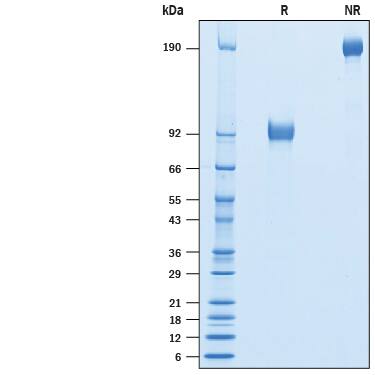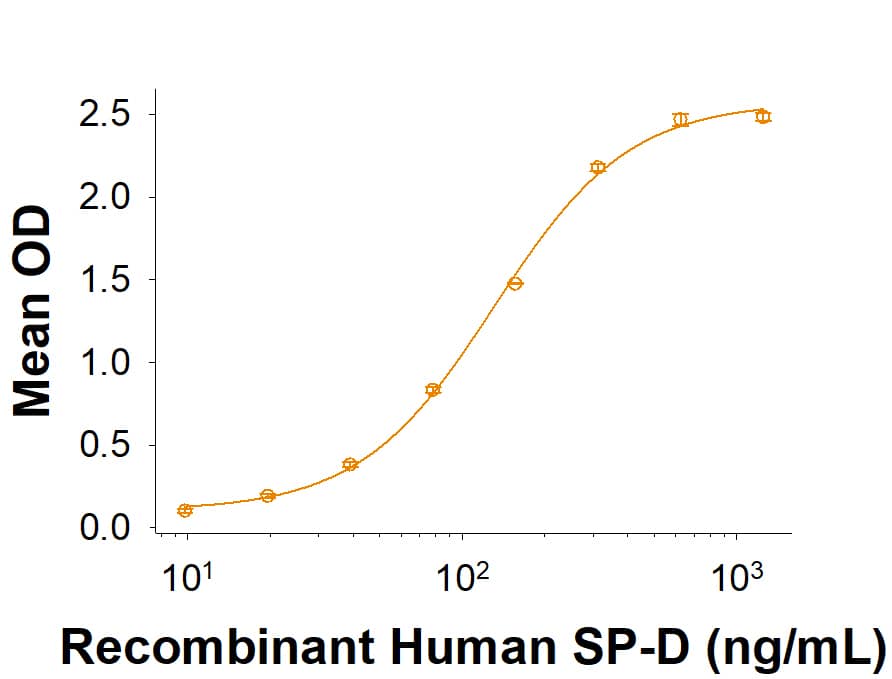Recombinant Cynomolgus SIRP beta 1/CD172b Fc Protein, CF
R&D Systems, part of Bio-Techne | Catalog # 10312-SB

Key Product Details
- R&D Systems CHO-derived Recombinant Cynomolgus SIRP beta 1/CD172b Fc Protein (10312-SB)
- Quality control testing to verify active proteins with lot specific assays by in-house scientists
- All R&D Systems proteins are covered with a 100% guarantee
Source
CHO
Accession #
Structure / Form
Disulfide-linked homodimer
Conjugate
Unconjugated
Applications
Bioactivity
Product Specifications
Source
Chinese Hamster Ovary cell line, CHO-derived cynomolgus monkey SIRP beta 1/CD172b protein
| Cynomolgus Monkey SIRP beta1/CD172b (Glu30-Pro369) Accession # XP_005568593.1 |
IEGRMD | Human IgG1 (Pro100-Lys330) |
| N-terminus | C-terminus |
Purity
>95%, by SDS-PAGE visualized with Silver Staining and quantitative densitometry by Coomassie® Blue Staining.
Endotoxin Level
<0.10 EU per 1 μg of the protein by the LAL method.
N-terminal Sequence Analysis
Glu30
Predicted Molecular Mass
64 kDa
SDS-PAGE
88-99 kDa, under reducing conditions
Activity
Measured by its binding ability in a functional ELISA.
When Recombinant Cynomolgus Monkey SIRP beta1/CD172b Fc Chimera (Catalog # 10312-SB) is immobilized at 1 µg/mL (100 µL/well), Recombinant Human SP‑D (Catalog # 1920-SP) binds with an ED50 of 40-320 ng/mL.
When Recombinant Cynomolgus Monkey SIRP beta1/CD172b Fc Chimera (Catalog # 10312-SB) is immobilized at 1 µg/mL (100 µL/well), Recombinant Human SP‑D (Catalog # 1920-SP) binds with an ED50 of 40-320 ng/mL.
Scientific Data Images for Recombinant Cynomolgus SIRP beta 1/CD172b Fc Protein, CF
Recombinant Cynomolgus SIRP beta 1/CD172b Fc Protein Binding Activity
When Recombinant Cynomolgus Monkey SIRP beta1/CD172b Fc Chimera (Catalog # 10312-SB) is immobilized at 1 µg/mL (100 µL/well), Recombinant Human SP-D (Catalog # 1920-SP) binds with an ED50 of 40-320 ng/mL.Recombinant Cynomolgus SIRP beta 1/CD172b Fc Protein SDS-PAGE
2 μg/lane of Recombinant Cynomolgus Monkey SIRP beta1/CD172b Fc Chimera (Catalog # 10312-SB) was resolved with SDS-PAGE under reducing (R) and non-reducing (NR) conditions and visualized by Coomassie® Blue staining, showing bands at 88-99 kDa and 170-200 kDa, respectively.Formulation, Preparation and Storage
10312-SB
| Formulation | Lyophilized from a 0.2 μm filtered solution in PBS with Trehalose. |
| Reconstitution | Reconstitute at 500 μg/mL in PBS. |
| Shipping | The product is shipped at ambient temperature. Upon receipt, store it immediately at the temperature recommended below. |
| Stability & Storage | Use a manual defrost freezer and avoid repeated freeze-thaw cycles.
|
Background: SIRP beta 1/CD172b
References
- vanBeek, E.M. et al. (2005) J. Immunol. 175:7781.
- van den Berg, T. et al. (2008) Trends in Immunology 29:203.
- Liu, Y. et al. (2005) Journal of Biological Chemistry 280:36132.
- Matozaki, T. et al. (2009) Trends in Cell Biology 19:72.
- Dietrich, J. et al. (2000) J Immunol. 164:9.
- Brook, G. et al. (2004) J Immunol. 173:2562.
- Hayashi, A. et al. (2004) J Biol Chem. 279:29450.
- Fournier, B. et al. (2012) J. Biol. Chem. 287:19386.
- Seiffert, M. et al. (2001) Blood 97:2741.
Long Name
Signal-regulatory Protein beta 1
Alternate Names
CD172b, SIRPB1
Gene Symbol
SIRPB1
UniProt
Additional SIRP beta 1/CD172b Products
Product Documents for Recombinant Cynomolgus SIRP beta 1/CD172b Fc Protein, CF
Product Specific Notices for Recombinant Cynomolgus SIRP beta 1/CD172b Fc Protein, CF
For research use only
